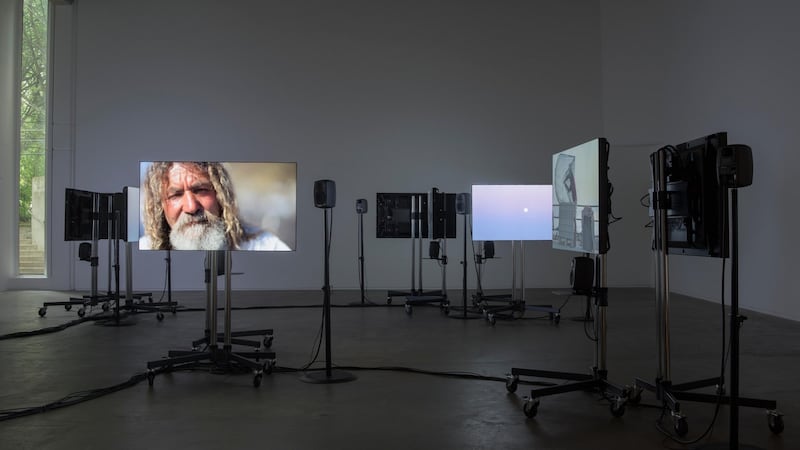A Visibility Matrix: Sven Anderson and Gerard Byrne (Gallery 1) The Artist's Eye: Juan Downey (Gallery 2)
*****
Douglas Hyde Gallery, Trinity College, Dublin
A Visibility Matrix has a purpose and a resonance way beyond its accumulated content which, incidentally, is vast and varied. The content is video material "aggregated from a network of collaborators". That's dozens and dozens of artists who have contributed video, an international roll-call of individuals far too long to list individually.
Visibility Matrix is "a synchronised, multi-channel video installation" but its point is not to, say, showcase an expansive range of video work, and it's not a greatest hits collection. That would make it a video art survey or compendium.
What’s intriguing about the project is that its creators – or directors or architects or perhaps designers – Sven Anderson and Gerard Byrne, have apparently not the slightest interest in or intention of making such a survey.
They are interested, however, in the structural framework within which content is organised, distributed, seen and experienced. The word consumed could also be slipped in there somewhere. Their novel methodology has produced, or is in the process of producing (because the project will keep evolving as it goes on to the Toulouse Arts Festival and then to Void Gallery in Derry) a work that has wide general relevance to contemporary culture, not least in that it has a serious stab at offering a critical view of how digital communications platforms operate. Its relevance also extends beyond the contemporary.

While such digital networks pervade 21st century urban life, Anderson and Byrne’s work is rooted in the pre-digital period of the 1960s-1980s. During this time a number of artists, with Nam June Paik as one notable example, explored the cultural implications of developing mass electronic communications and imaging technologies.
Hyperstimulation
In the mid-1970s Paik coined a new term in anticipating the arrival of “electronic super highways”. Stacks of video monitors, multiple and composite imagery, and even algorithmic programming gained currency in works that didn’t just exploit an available technology but queried and pushed it to deal with a range of ideas relating to anything from perception to communication, veracity to mythologising, commercialisation to cognition.
Artists such as Paik addressed “visual excess and hyperstimulation prior to the development of the internet,” Anderson and Byrne point out, and before video technology became staggeringly malleable and ubiquitous, embedded in urban streetscapes, shopping malls, concert venues, bars and cafes, homes and phones, shops and museums.
Reach back 40 years, and video installations were imposingly material affairs: heavy boxes and cables, cathode ray tubes and other cumbersome, bulky stuff. What happened in the meantime could be described as the dematerialisation of the technology as computational power grew exponentially while the actual computers shrank, monitors flattened and wireless communication took flight. As Anderson and Byrne frame it, we arrive at the “subject+smartphone+online-video-sharing-platform” model “that has come to represent the current standard of visibility.”

By contrast, they have devised a structure that restores materiality and presence to the interaction between subject and video, while also echoing and implicitly querying the dominant paradigm of contemporary visual culture. A labyrinth of large flat-screen monitors (designed to work individually, or in unison so that each could display a fragment of an overall image) occupies the main gallery space, tethered by thick bunches of black cables that snake across the floor and, apart from those providing power, lead back to two processors chugging away on a shelf on the landing above.
They are the brain issuing instructions on what we see on the monitor maze. What we see is presumably trawled from the ocean of video by those many collaborators, and the displays generated by algorithmic processes devised by another collaborative team, fewer in number but reflecting a diversity of relevant disciplines. Duplication, mirroring and displacement come into play. Vitally, it is not an open system. It is offline, and wired, though of course unpredictable.
Hypnotically watchable
It leads seamlessly into The Artist's Eye work in Gallery 2, Juan Downey's 1974 video Moving, which is displayed piecemeal in partial images and whole on a monitor with soundtrack in the small gallery enclosure.
Downey was one of the pioneering video artists cited by Anderson and Byrne, and his work is appropriately screened on those black box-like monitors favoured by Paik et al.
Chilean, Downey trained as an architect but found his way to New York and artistic work across a number of disciplines (drawing remained a lifelong passion). The project of which Moving is part, Video Trans Américas, consisted of a series of videos and installations based on Downey's journeys through America north and south in the 1970s. He worked with a Sony Portapak, an early battery powered video recorder that galvanised video production. Downey grasped the technology as a means of disrupting top-down cultural hierarchies.
Moving is hypnotically watchable. As the title suggests, it is simply a moving-eye view, encompassing several modes of communal transport. It builds up terrific momentum and reveals a succession of ordinary and extraordinary landscapes and environments, all animated by the pulse of collective human activity.
One can see its appeal for Anderson and Byrne, as they look back to a moment of optimism about “electric super highways” as egalitarian and progressive agencies.
In the event, it looks as if that optimism was to a significant degree misplaced, and among other things A Visibility Matrix attempts to persuade us to aim for technological engagement as active agents rather than passive consumers. It is a rich work that offers many points of contact and room for speculative analysis. Incidentally, it also seems in line with Byrne's recent strand of work built on "the legacies of minimalism", such as In Our Time from 2017.
Both exhibitions are at the Douglas Hyde Gallery, Trinity College Dublin, until August 25th douglashydegallery.com



















